Services on Demand
Journal
Article
Indicators
-
 Cited by SciELO
Cited by SciELO -
 Access statistics
Access statistics
Related links
-
 Cited by Google
Cited by Google -
 Similars in
SciELO
Similars in
SciELO -
 Similars in Google
Similars in Google
Share
CT&F - Ciencia, Tecnología y Futuro
Print version ISSN 0122-5383On-line version ISSN 2382-4581
C.T.F Cienc. Tecnol. Futuro vol.3 no.1 Bucaramanga Jan./Dec. 2005
ABSTRACT
In recent years, the use of nitrogen has increased as gas injection to recover oil fluids near the critical point. The behavior of hydrocarbon mixture phases in the critical region shows very interesting complex phenomena when facing a recovery project with nitrogen. Therefore, it is important to have experimental information of the PVTx thermodynamic variable, often scarce, for this type of critical phenomena. This paper reports the experimental measures of the volumetric behavior and phases of synthetic fluid in a nitrogen injection process. The experiment was performed at laboratory scale, and it obtained variations on the saturation pressure, gas oil ratio, density and composition of the hydrocarbon phase when nitrogen was injected at molars of 10, 20, 30 and 40% on different volumetric portions of the mother sample. In addition, the data obtained experimentally was used to demonstrate the capacity of tune to compositional models. The data provided represents a valuable contribution to the understanding of phenomena associated with retrograde and near critical regions, as well as their use in tuning and developing more elaborate models such as Cubic Equations of State (EOS). It is worth highlighting the importance of this data in the potential processes of nitrogen, CO2, and lean gas injection, which require knowledge of the gas-oil ratio, saturation pressures, density and composition of the fluid in current production. The identification of the phenomena shown, represent a potential application to the modeling of displacements and maintaining the pressure in the improved recovery when scaling up the laboratory data to the field / reservoir conditions.
Keywords :gas injection, phase behavior, equation of state (EOS), critical region, retrograde region.
RESUMEN
En años recientes se ha incrementado el uso de nitrógeno como gas de inyección para recuperar fluidos de petróleo cercanos al punto crítico. El comportamiento de fases de mezclas de hidrocarburos en la región crítica presenta fenómenos complejos de gran interés cuando se trata de encarar un proyecto de recuperación con nitrógeno. Es conveniente por tanto, tener información experimental de las variables termodinámicas PVTx, muchas veces escasas para este tipo de fenómenos críticos. El presente artículo reporta las medidas experimentales del comportamiento volumétrico y de fases realizadas sobre un fluido sintético en un proceso de inyección de nitrógeno. El experimento realizado a escala de laboratorio obtuvo las variaciones de la presión de saturación, relación gas aceite, densidad y composición de la fase de hidrocarburos al inyectar nitrógeno al 10, 20, 30 y 40% molar sobre diferentes porciones volumétricas de la muestra madre. Adicionalmente se utilizaron los datos obtenidos en forma experimental para demostrar la capacidad de ajuste a modelos composicionales. Los datos suministrados representan un aporte valioso en el entendimiento de los fenómenos asociados a las regiones retrogradas y cercanamente crítica, además de su uso en el ajuste y desarrollo de modelos más elaborados como las Ecuaciones Cúbicas de Estado (EOS). Es de resaltar la importancia que representan estos datos en los procesos potenciales de inyección de nitrógeno, CO2, y gas pobre, donde se requiere el conocimiento de las relación gas-aceite, presiones de saturación, densidades y composiciones del fluido en producción actual. La identificación de los fenómenos presentados representa una aplicación potencial al modelamiento de desplazamientos y mantenimiento de presión en el recobro mejorado al escalar los datos de laboratorio a condiciones de campo-yacimiento.
Palabras clave: gas de inyección, comportamiento de la fase, ecuación de estado (EOS), región crítica, región retrograda.
INTRODUCTION
The behavior of nearly critical phases of fluid is very important for the majority of the high pressure processes, such as super-critical extraction of fluids, exploitation of condensed gas and volatile oil critical reservoirs and gas injection in improved recovery processes (Moses and Wilson, 1978; Boersma and Hagoort, 1994; Lamus, 1997; Gharbi et al., 2000; Steve et al., 2002). As pressure decreases in a volatile oil reservoir, it is convenient to inject gas in order to maintain a high pressure that will favor the extraction of the fluid. (Thomas et al., 1991; Danesh et al., 1991). In recent years, the use of nitrogen as injection gas has increased for the purpose of recovering and maintaining the pressure of oil fluids close to the critical point. nitrogen has the advantage that it is not a reactive molecule and it may be extracted from the atmosphere. To learn and to understand how N2 modifies the PVTx thermodynamic properties of crude in its oil and/or gas phases, would allow us to develop more efficient and clear strategies for the extraction and separation of reservoir crudes. It would also provide a powerful too for tuning and developing EOS (Soreide, 1989; Chou and Prausnitz, 1989; Danesh et al., 1990; Bjorlykke and Firoozabadi, 1992; Peláez and Escobar, 1995). Although the behavior of the mixed phases and binary and tertiary PVT ratios that contain nitrogen has been studied in experiments of many systems, creating and immense amount of data which can be correlated for research purposes (Llave et al., 1985; Wisotzki and Schneider, 1985; Leeuw et al., 1989; Sadus, 1992) such data measured for multi-component mixtures in critical regions are scarce. In this study, we obtained measured variations of saturation pressure, gas oil ratio, density and composition of the hydrocarbons phase by injecting nitrogen at molars of 10, 20, 30 and 40% on different volumetric portions of the mother sample (a synthetic and discrete mixture of nitrogen, methane, n-butane and n-tetradecane). As well the Peng Robinson (PR), EOS was tuned to saturation pressure data from the mixture of different percentages of injected N2. The foregoing in order to illustrate how an appropriate thermodynamic model is established, to equal the experimental data and its subsequent use in additional tests.
EXPERIMENTAL DESIGN
During the investigation we manipulated the independent variable, molar of nitrogen. From a synthetic sample with an initial concentration of nitrogen, the amount of nitrogen was varied in three volumetric portions of the standard sample, represented in molars of 10, 20, 30 and 40%. The value of three independent variables was established for each percentage of N2. Saturation Pressure(MPa): three replicas for five concentrations of nitrogen, including the initial sample, by constant composition expansion (CCE). Gas-oil ratio (m3/m3): three replicas for four concentrations of nitrogen, taking into account the mother sample, by determining the gas-oil ratio. Density of the fluid under reservoir conditions (g/cc): three replicas for four concentrations of hydrogen including the mother sample, through gravimetric testing.
Experimental site
Testing was performed in the PVT analysis lab (Pressure, Volume and Temperature) of the Instituto Colombiano del Petróleo (ICP), ECOPETROL S.A. With accreditation of its technical competence as sampling and testing laboratory, granted by the Colombian Superintendency of Industry and Commerce, ISO-NTC Standard 17025. Equipment In order to perform the experiments we basically used the following equipment: two phase behavior equipment, a GOR apparatus, two chromatographers, an electronic analytical scale, a cylinder, high-pressure lines and connectors. Positive displacement volumetric pump, work pressure range 0 - 68,9476 MPa, volumetric capacity 250 cc, oven, thermostated air bath, temperature controllers and thermometer. GOR apparatus is used to determine the gas-oil ratio. It has a cylinder and a piston (gas meter) which receives the gas sample, when it is released from the pycnometer that carries the sample that represents the fluid of the reservoir. The pycnometer is filled with a known volume of representative sample and it is installed in the GOR apparatus. Here the gas circulates through the liquid in order to have a more dynamic contact and to establish a representative mixture of gas. Gas chromatographer for the gaseous and liquid phases, equipment used to determine the composition of the gaseous and liquid phases respectively corresponds to a Hewlett Packard Chromatographer, Model 6890. Metler scale, work range from 0 to 1200 g, resolution 0,1 mg, used to determine the weight of the pycnometer with and without sample. Pycnometer, stainless steel cylinder with average capacity of 50 cc, with known volume, used to capture volume of the sample transferred from the cell for different operations, amongst them to determine the density and the chromatographic analysis.
Fluid system
A synthetic sample was created with four components methane (C1), normal butane (nC4), and normal tetradecane (nC14) and nitrogen (N2). One of the main reasons for choosing this type of mixture is that, on the one hand it has well defined properties of all the components, and on the other hand the difference in volatility among its extreme components generates extensive retrograde and critical areas. The purity of all the components exceeds 99,6 % in weight. The concentration of each component in the injections is equivalent to a molar of 59,26; 31,12; 6,17 and 3,45 % for C1, nC4, nC14 and N2 respectively. Table 1 shows the data of the critical properties and normal boiling point for each of the components of the mixture.

PROCEDURES
Following is a description of the testing procedures performed throughout the investigation which comprise from preparing the synthetic sample, to injecting nitrogen, as well as determining the saturation pressure, gas-oil ratio, density and composition of the sample at reservoir conditions.
Preparation of the mother sample (recombination)
In a clean and hydrostatically tested recombination cylinder, and knowing its volume, 1200 cc, inject the precalculated amount of n-Tetradecane for the approximate concentration of 7% molar. Then inject the same amount of methane up to an approximate concentration of 60% molar, followed by introduction of n-butane up to an approximate concentration of 33% molar and finally inject to the same cylinder a known amount of nitrogen at 4% molar. The injection is done from individual cylinders of each component to the recombination cylinder at laboratory temperature and average pressures of 27,6 MPa. Internally, the cylinder has Teflon spheres that favor the mixture of the components during seven days of shaking, at laboratory temperature of 291,2 K and pressure of 48,3 MPa. This is the way to obtain a synthetic sample of hydrocarbons in just one phase. From the characterization of the standard sample, we continue with the following tests.
Constant composition expansion (CCE)
From the CCE test we basically obtain the saturation pressure, compressibility of the fluid and an analytic function to correlate the relative volumes under the saturation pressure (Pedersen et al., 1989; Whitson and Brule, 2000).
Density of the fluid at reservoir conditions (g/cc)
The main objective of this test is to measure the variation of density from the reservoir pressure to the atmospheric pressure.
Determination of gas-oil ratio (m3/m3)
Install the pycnometer where the sample was taken to determine the density of the fluid at reservoir conditions, in the port of entry of the GOR apparatus, where air is re-circulated at controlled temperature, through the cylinder, and additionally shaking it to obtain a gaseous phase in thermodynamic balance with the oil phase at separator conditions. Once the density, weight and volume have been determined it is weighted. The gas is quantified in the internal gas meter. This way we can obtain a reliable GOR.
Determination of fluid composition at reservoir conditions
Basically recombine the compositions obtained from the liquid and gaseous chromatographies, in order to obtain the composition of the reservoir fluid in just one phase (McCain Jr., 1990).
Nitrogen Injection
With gaseous nitrogen available in a high-pressure cylinder, inject a precalculated volume on a portion (50 cc) of the synthetic sample (mother sample) which should be in the cell at reservoir conditions; for all the other concentrations proceed likewise and at different times. Inject nitrogen for the first portion up to 10% molar, inject nitrogen to the second portion up to 20% molar and inject the third portion up to 30% molar, and then perform a constant composition expansion (CCE) test. Subsequently, reinstate pressure and proceed to inject more nitrogen up to a concentration of 40%. For the mixtures with molar concentration of 10, 20 and 40% perform tests to determine the saturation pressure, gas-oil ratio, density and composition at reservoir conditions.
RESULTS AND ANALYSIS
Table 2, show the experimental results of the PVT thermodynamic and equilibrium properties for the different percentages of N2 (10, 20, 30 and 40%) added to the basic fluid, representing a high shrinkage volatile or near- critical oil. The definition of "high shrinkage" fluid was taken from comparing the density of the mother sample with specific gravity values pressure gradients tabulated by Dahlberg (1995). In addition, the average conditions of pressure, temperature and composition of the fluids of the Piedemonte Llanero in Colombia were assumed as basic, so that the basic sample would represent a high-shrinkage volatile critical fluid. As well the compounds chosen show considerable differences in their volatility (consider the boiling point of N2, C1, and n-C14, Table 1.) which allows us to expand the retrograde and critical region to be studied. As well the relation or interaction between components such as C1 and n-C4, or n-C4 and n-C14 which at high pressures and temperatures show adequate mass transfer processes, as in the real scenarios of nitrogen injection or compositional behaviors (Lee et al., 1994).
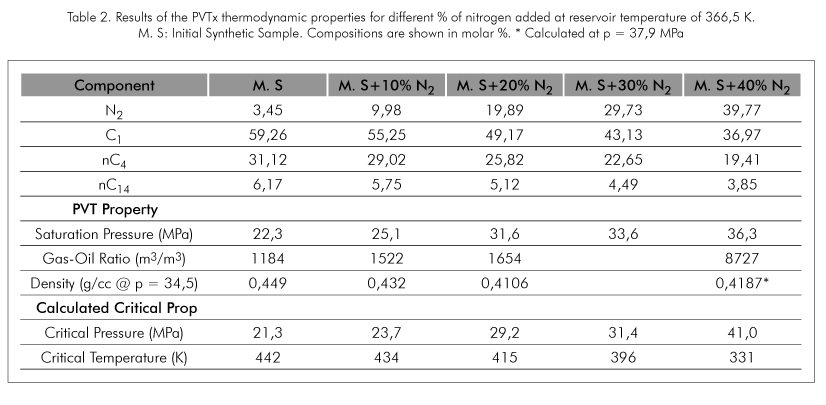
The properties shown in Table 2 represent average values of three replicas measured for each one of them, as stated at the beginning of the experimental design section. The concentration of 30% nitrogen was experimentally determined; the saturation pressure used (together with the other measured saturation pressures) with the purpose of tuning the EOS models and PT calculations, will be described in detail further on. The reservoir density data at a temperature of 366,5 K and pressure of 34,5 MPa, except for 40% N2, which was measured at 37,9 MPa, corroborates a consistent behavior that decreases with the increasing amount of nitrogen, which is logical because the N2 contributes to a lower average density of the mixture, see Table 2. The total GOR value experimentally obtained for the mother sample, characterizes it as a condensed gas (McCain, 1994), although there could exist volatile oils with GOR above 623 m3/m3 and heavy fractions under 12%, or a condensed gas with GOR de 623 m3/m3 and a heavy fraction content above 12%, (McCain, 1994). This identifies fluids of great complexity such as the nearly-critical. Figure 1, shows GOR increase with the amount of nitrogen injected, for our study. It clearly shows the consistency of the experimental data, because by increasing the concentration of nitrogen, the gas proportion of the sample increases. Figure 1 represents the molar percentage of N2 added per mole of original fluid, that is to say, that the basic fluid is zero, has nitrogen ("naturally") but has not been injected yet.
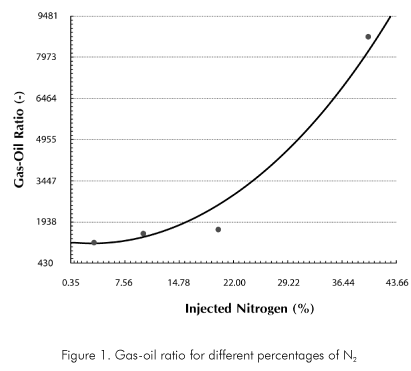
Making an analogy with the GOR curves against the time of retrograde gases and volatile oils, Figure 1 shows us two relatively well defined sections. The first one corresponds to the first N2, addition points, which show us an increase of the volatile oil GOR. The second one, living together the two final points, shows us a prototype GOR of condenses gas. This seems to reveal a transition from the bubble point to the dew point. So far, the experimental data shows an important tool to reaffirm our knowledge of complex PVT behavior phenomena, and it also sheds "light" to interpret new phenomena. In the following section we will use the experimental data of the first stages to the tuning the EOS models in order to be able to make a more extensive and detailed PTx analysis.
With the experimental data of saturation pressure, we tuned the PR equation of state of a PVT simulator, and proceeded to generate the envelopes for each of the experimental compositions with their respective fraction of nitrogen, so that the saturation point curves would touch the experimental points. The foregoing technique is frequently used in improved recovery processes to create compositional models that later on will couple with reservoir simulators in order to establish an adequate thermodynamic model for each reservoir and/or oil field. It is not the objective of this article to go in depth on the subject of regression and tuning of EOS (Silva and Rodríguez, 1992; Whitson and Torp, 1983; Coats and Smart, 1982). Simply the tuning or regression methodology followed for this works, modifies the coefficients of binary interaction (forces of attraction) between the components and the heaviest critical component, nC14. Figure 2 shows the evident increase in saturation pressure with the increase of nitrogen gas in the mixture of hydrocarbons. The pressure goes from an initial value of 22,3 MPa to 36,5 MPa. The pressure changes once more make the experimental data and their reliability evident.
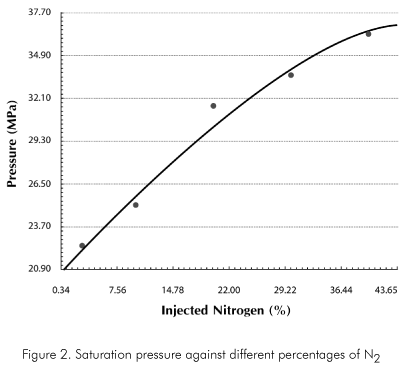
Figures 3, 4 and 5 show the PT phase diagrams for the initial mixture and the mixtures with percentages of 30 and 40% nitrogen. These Figures show us the transition of the initial fluid mixture considered a high-shrinkage volatile oil, to a condensed gas. Observe Figures 3 and 4, where both show the fluid at bubble point (black triangle on the left hand side) at a reservoir temperature of 366,5 K, Figure 4 has a higher pressure because it has a higher content of N2 (30%), dynamically displacing the phase diagram towards the left, that is towards the nitrogen. The concave area which is seen in the upper left hand side of Figure 4, doesn´t have any experimental evidence for the case in point and could arise due to the tunes values taken by the binary interaction coefficients, which at low temperature, show inconsistencies, Pedersen et al. (1989). In this particular paper, we are interested in the nearly critical region.
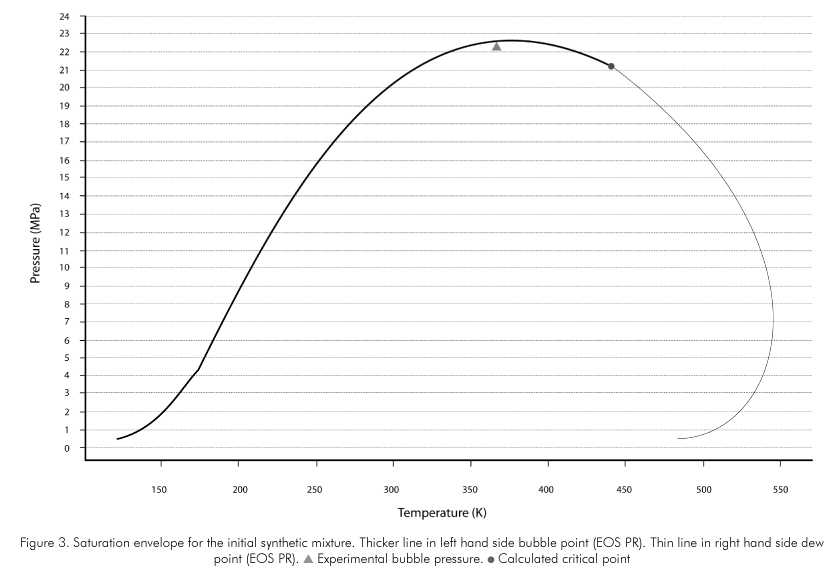
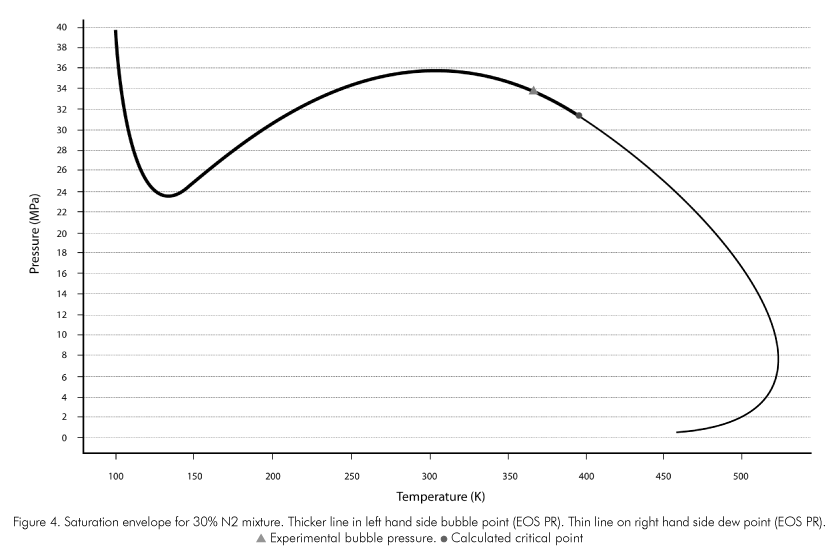
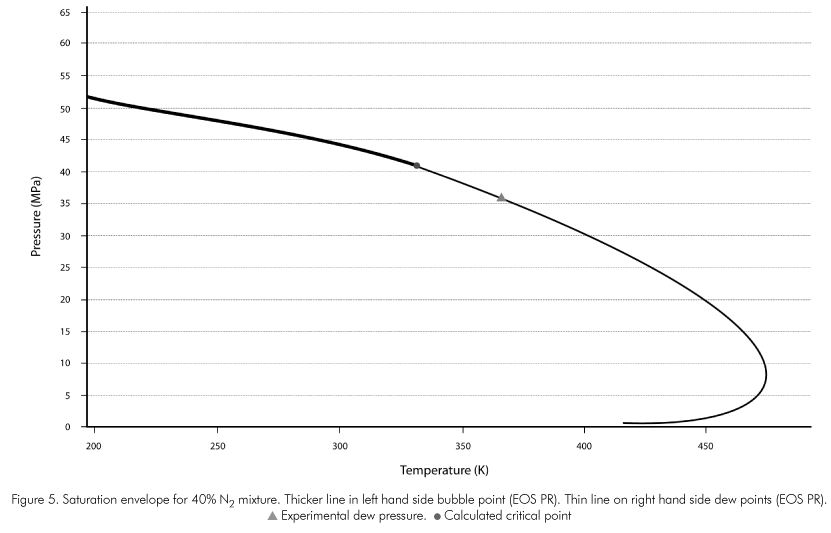
The phenomenon continues moving and at one point there is a coincidence of the reservoir temperature 366,5 K, with the critical temperature of the mixture. If we observe Figure 5, at a percentage of 40 nitrogen, we verify that it is a dew point (black triangle on the right hand side) at reservoir temperature of 366,5 K. The distance that exists from the dew point to the critical point of the mixture is considerable, making it evident that the transition may have occurred at concentrations of N2 around 32-35%. If the phenomena or displacement process continues upward, (maintaining pressure) and towards the left (changing the fluid) we could expect an addition of nitrogen such that it would "pull out" the fluid of the study from the envelope of the phases. The foregoing allows us to consider different alternatives to recover fluid from the reservoir, because of the fact of being able to work with only one phase of greater mobility. More precisely, a reservoir with volatile oil type fluid, close to the critical point, which will be subject to a pressure maintenance or improved recovery process. It could become a reservoir fluid, such as condensed gas (even wet) and this change could occur at low concentrations of nitrogen, depending of its proximity to the critical point.
Figure 6 dynamically shows the whole change of fluid type process. The lower line is the saturation curve for the initial sample (3,45 % N2) and the upper curve is the saturation envelope for a percentage of 40 N2. This figure includes the envelopes for nitrogen percentages of 10 and 20%. It clearly shows how the distance from the critical point to the initial experimental bubble point decreases, until they coincide and subsequently it becomes a dew point.
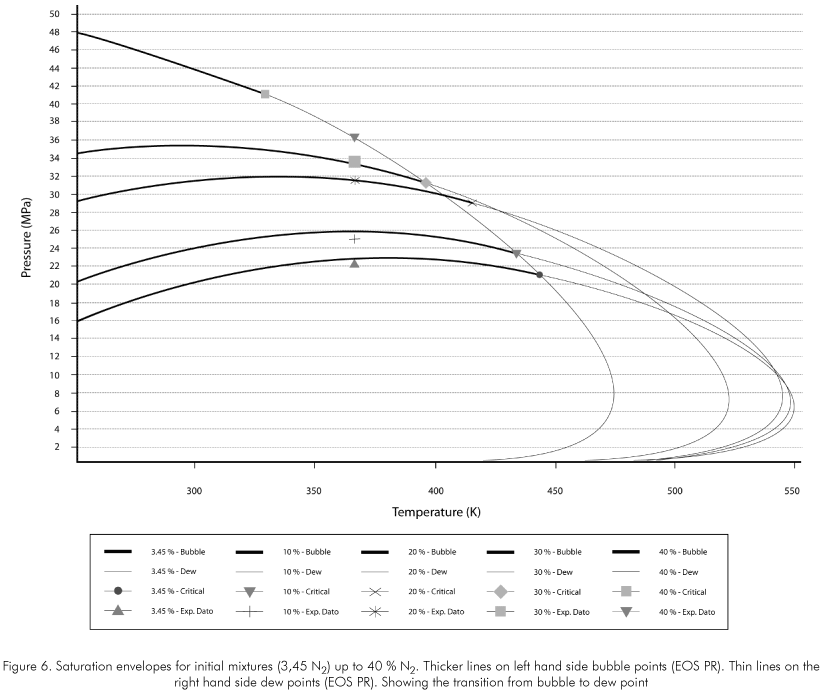
CONCLUSION
• Experimental variations were obtained with a Constant Composition Expansion test of the thermodynamic variables: saturation pressure, density and composition of the hydrocarbons phase when injecting nitrogen at 10, 20, 30 and 40% molar on different volumetric portions of a synthetic mother sample, characterized as high-shrinkage volatile critical fluid. The data provided was used to tune an EOS model and represent high complexity phenomena such as the changes in the critical regions with volatile to condensed fluid type. By understanding the phenomena associated to the retrograde and nearly critical regions, we were able to elucidate new alternatives when facing a gas injection project, more specifically nitrogen injection. Identification of the phenomena represents a potential application to modeling the displacements and maintaining the pressure in the improved recovery when scaling up the laboratory data to the field-reservoir conditions.
ACKNOWLEGMENTS
The authors express their most sincere gratitude to ECOPETROL S.A., Instituto Colombiano del Petróleo (ICP) for their valuable cooperation.
REFERENCES
1. Bjorlykke, O. P. and Firoozabadi A., 1992. "Measurement and Computation of Near-critical Phase Behavior of a C1/nC24 Binary Mixture" SPE Reservoir Engineering, 271-277. [ Links ]
2. Boersma, D. M. and Hagoort, J., 1994. "Displacement Characteristics of Nitrogen vs. Methane Flooding in Volatile - Oil Reservoirs". SPE Reservoir Engineering, 261-265. [ Links ]
3. Coast, K. H. and Smart, G. T., 1982. "Application of a Regression - Based ESO PVT Program Laboratory Data". SPE 11197. [ Links ]
4. Chou, F. G. and Prausnitz, J. M., 1989. "A Phenomenological Correction to an equation of State for the Critical region". AIChE Journal, 35(9): 1487-1496. [ Links ]
5. Dahlberg, E. C., 1995. "Applied hydrodynamics in Petroleum Exploration". Springer - Verlang, Second Edition, Alberta, Canada, 1-14. [ Links ]
6. Danesh, A. and Todd, A. C., 1991. "Comparative Study of Cubic Equation of State for Predicting Phase Behaviour and Volumetric Properties of Injection Gas - Reservoir Oil Systems". Fluid Phase Equilibria, 63, 259-278. [ Links ]
7. Danesh, A., Dong - Hai, X. and Todd, A. C., Heriot - watt, U., 1990. "An Evaluation of Cubic Equations of State Phase behavior calculations Near Miscibility Conditions". Seventh Symposium on Enhanced Oil Recovery, Tulsa, Oklahoma, SPE/DOE 915-924. [ Links ]
8. Gharbi, R. B., Qasem F. and Peters, E. J., 2000. "A Relationship Between the Fractal Dimension and Scaling Groups of Unstable Miscible Displacements". SPE 63001. [ Links ]
9. Hustad, S. O., Klov, T., Lerdahl, T. R., Berge, L. I., Stensen, J. A., Oren, Pal-Eric., 2002. "Gas Segregation During WAG Injection and the Importance of Parameter Scaling in Three-Phase Models". SPE 75138. [ Links ]
10. Lamus, J. F., 1997. "Estado del Arte sobre los Métodos de Recuperación Mejorada de Petróleo: Criterios de Selección y Aspectos Técnicos". Visión Tecnológica, 4 (2): 165-177. [ Links ]
11. Lee, S. T., Gomez, P. A. and Toczylkin, L., 1994. "An Integrated Approach to Interpreted and Compositional reservoir Simulation". SPE 27581. [ Links ]
12. Leeuw de V. V., Poot, W., Loos, Th. W. and Swaan, A., 1989. Fluid Phase Equilib., 49, 75-101. [ Links ]
13. Llave, F. M., Luks, K. D. and Kohm, J. P., 1985. Chem. Eng. Data, 30, 435-438. [ Links ]
14. McCain, W. D., 1994. "Revelation About Reservoir Fluids". Petroleum Engineer International. [ Links ]
15. McCain, W. D., 1990. "The Properties Of Petroleum Fluids". PennWell Publiching Company Tulasa. [ Links ]
16. Moses, P. L. and Wilson, K., 1978. "Phase Equilibrium Considerations in Utilizing Nitrogen for Improved Recovery from Retrograde condensate Reservoirs", 53rd Annual Fall Technical Conference and Exhibition of the Society of Petroleum Engineers of AIME, Houston. TX. USA. SPE 7493, [ Links ]
17. Pedersen, K. S., Fredenslund, Aa. and Thomassen, P. T., 1989. "Properties of Oils and Natural Gases". In: Contributions in Petroleum Geology and Engineering, 5, Gulf Publishing Company, Book Division. Houston, London, Paris, Tokyo, Zurich. [ Links ]
18. Pelaez, C. V. y Escobar J. C. M., 1995. "Un Simulador para el Estudio del Comportamiento de Fases" basado en: La Ecuación de Estado de Soave y Cálculos de Balances de Materia. CT&F-Ciencia Tecnología y Futuro, 1 (1): 83-94.
19. Sadus, R. J., 1992. "High Pressure Phase Behaviour of Multicomponent Fluid Mixtures", Elsevier. [ Links ]
20. Silva, M. B. and Rodriguez, F., 1992 "Automatic Fitting of Equations of State for Phase Behaviour". SPE 23703. [ Links ]
21. Soreide, I., 1989. "Improved Phase Behavior Prediction of Petroleum Reservoir Fluids From A Cubic Equation of State", Dr. Techn. Thesis Norwegian Institute of Technology, Department of Petroleum Engineering. [ Links ]
22. Thomas, L. K., Dixon, T. N., Pierson, R. G., Hermansen, H. Ekofisk., 1991. "Nitrogen Injection". SPE Formation Evaluation. [ Links ]
23. Whitson, C. H. and Brule, M. R., 2000. "Phase Behavior". SPE Monograph Series, Richardson, Texas. [ Links ]
24. Whitson, C. H. and Torp, S. P., 1983. "Evaluation Constant - Volume Depletion Data". J. of Petroleum Techn., 610-620. [ Links ]
25. Wisotzki, K. D. and Schneider, G. M., 1985. Ber. Bunsenges. Phys. Chem., 89, 21-25. [ Links ]














